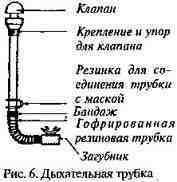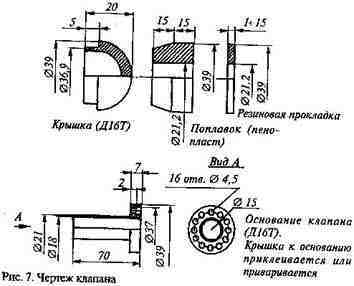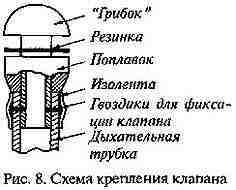Can't say for definite what the catch is, if catch it is. My first thought was Brussels sprouts, but closer examination indicated some kind of shellfish. I'm certain the original web page on Avito, Russia's equivalent of eBay, didn't leave me any wiser.
Back to breathing tubes and this may be my last in this thread. I promised to post something about Soviet snorkels with valves, which was a do-it-yourself enhancement, not a commercial option as far as I have been able to ascertain.
Snorkels with valves
The snorkels on the right of the above image are among the few I have been able to locate with fitted valves. I get the impression that there were plenty of valved snorkels on the USSR's drawing boards, but they never ended up in commercial production.
Awareness of the limited benefits of valved snorkels
Soviet diving and spearfishing manual writers were clearly aware of western forays into the manufacture of such snorkels as well as the disadvantages of such device enhancements:
The illustration above is from a Soviet manual about diving equipment, whose Russian text you can access for yourself at
Маски (полумаски, очки), дыхательные трубки, ласты. Here is a rough English translation; I have changed the lettering on the illustration from Cyrillic alphabetical order "е, ж, з, и, к, и, л" to Roman alphabetical order "f, g, h, i, j, k.":
Fig. 22. Breathing tube design.
Some breathing tubes have automatic safety valves at the top end, whose purpose is to prevent the ingress of water into the tube while diving (Fig. 22fgh). A number of such tubes (fig. 22, h) have a purge valve at the bottom, allowing water lodged in the tube to clear with each exhalation.
We are aware of two types of safety valve: ball and float (Fig. 22ijk). The ball valve is the simplest, consisting of a rubber cage with side windows and a celluloid ball, which sits in its socket blocking access of water to the snorkel when the tube submerges. Use of a ball valve requires the top of the tube to bend over or to have a special nozzle, which increases inhalation resistance by 50- 60 mm of water and exhalation resistance by much more.
The presence of automatic valves does not preclude the possibility of water entering the tube, which may result in undesirable consequences if it happens unexpectedly to the swimmer.
The unreliability of automatic valves and their elevated breathing resistance restrict the use of breathing tubes with valves. Their primary use is in combination with masks, where the breathing tubes pass through the side or the top to the space within the mask, without ending in a mouthpiece (see Fig. 14ad).
Valved snorkels as a do-it-yourself project
Vitaly Vinogradov has written several books and articles on Soviet spearfishing, one of which contains a chapter about adding a mushroom valve to a snorkel. It is also online, at
Виноградов, so I'll just provide here a rough rendering into English.
Breathing tube with valve
Fig. 6. Breathing tube: Valve - Mounting and stop for the valve - Elastic band for connecting the tube to the mask - Bandage - Corrugated rubber tube - Mouthpiece.
This essential element of equipment takes on an entirely different form after all the proposed alterations and additions have been made (Fig. 6). Cut off the angled portion of a shop-bought plastic snorkel and replace it with a section of corrugated tubing, 15-18 centimetres in length. You can use the corrugated hose from a vintage gas mask. Attach the rubber tube to the plastic one by winding thick nylon thread with turn touching over a length of two centimetres. After securing the end of the thread, coat the whole hose with waterproof glue and cover it with vinyl tape. The corrugated portion of the tube allows the hunter to dispose of the mouthpiece on the surface with no hands: simply open your mouth and the mouthpiece comes out and drops away to the side. This comes in useful if you are in the water and you need to exchange information with anyone, or if the snorkel is no longer breathable for some reason and bypassing it enables breathing.
Fig. 7. Dimensional drawing of valve. Cover (D16T). Rubber seal. Float (foam). Type A. 16 OMV. Valve base (D16T). Cover glued or welded to the base.
Another even greater advantage of this renovation is that the flexible portion of the tube dampens the constant vibrations in its top part while swimming in dense grass, or rather, it does not transfer these vibrations to the mouthpiece, and, ultimately, to the inner surface of the swimmer’s lips. Previously, after hours of swimming, the mouthpiece would rub skin off. It is finally easier to penetrate dense grass and twigs with this snorkel, folded back if necessary and lying in the hunter’s plane of motion. The operating principle of the valve is simple: when descending, the foam float rises and presses the rubber seal into the holes, blocking them and preventing water from entering the tube. When ascending, the float drops down under its own weight along with the rubber seal, opening up all the holes.
Fig. 8. Blueprint for valve attachment. “Mushroom”. Rubber seal. Insulating tape. Float. Studs for securing valve. Breathing tube.
The dimensions in the figure have been selected using empirical evidence and tested in practice. The fundamental point in the design is the balance between the total volume of the bypass holes (4.5 mm) and the internal bore of the tube: the first should be equal to or greater than the second, otherwise there will be breathing difficulties. At first, the valve’s sole purpose, when submerged, was to prevent the snorkel from releasing air, whose gurgling sounds would scare the fish away. Later on, its other positive features emerged. For example, when ascending into very dense grass, it will almost certainly clog up a conventional snorkel and no breathing will be possible without removing the grass by hand. Worse still, you could end up surfacing under a layer of duckweed where breathing results in a portion of these small floating plants being sucked in with the air. The valve reliably prevents such misadventures.
The invention, once again, is appreciated when beginning winter hunting. Indeed, what a ‘pleasure’ it is to rinse one’s teeth in icy water for a few hours. Although the valve is sufficiently streamlined, it still sometimes catches on the littoral branches of bushes. We have to pull the snorkel firmly out of its captivity. The valve, therefore, may come off the tube if it is not rigidly attached. Such incidents do happen. The proposed fastening is safe, reliable and very easy to put into practice. When installing the valve, the distance from the mushroom to the float at its fully lowered point should be chosen by experimentation in such a manner that a sharp intake of breath does not cause the rubber seal to be sucked on to the mushroom. The tube is anchored to the mask by a rubber loop specially cut in a figure of eight. This soft fastening prevents the transfer from the tube to the mask of jerks and vibrations that might otherwise displace the mask, allowing water to leak inside. Since this fastening is not immune to rupture at the most inappropriate moment, be sure to cut out two such rubber loops at the same time and simply put the second one on the tube for an emergency. It does not prevent the moment from happening, but it will come to the rescue. Finally, the tube must be on the left side of the mask, because the hunter has his speargun in his right hand, leaving his left hand free and, if necessary, able to hold back the tube or remove it from grasses or drain water out of the mask.
Soviet patent for a snorkel with a valve
Finally, here is a Soviet patent for a valved breathing tube:
Трубка для подводного плавания — SU 1694165
I don't have an English translation this time, but hopefully the patent drawings will convey the drift. I am going to move on next to the masks, snorkels and fins produced elsewhere in pre-1990s Eastern Europe, starting probably with the German Democratic Republic, which we tend to call "East Germany".












